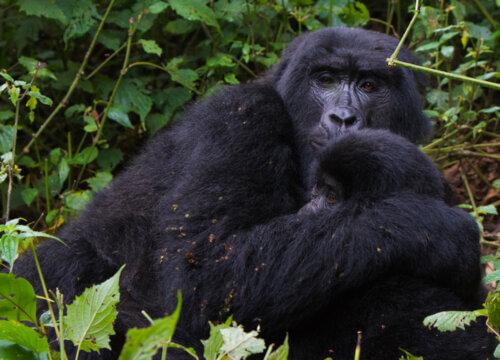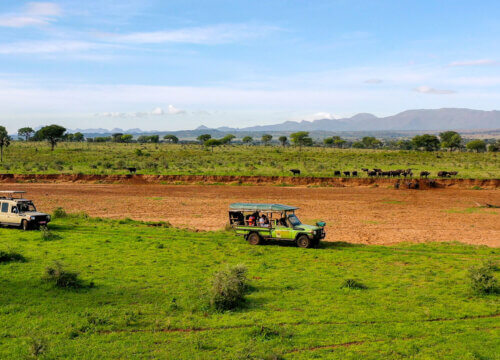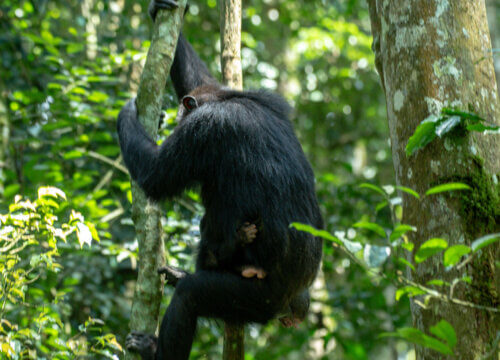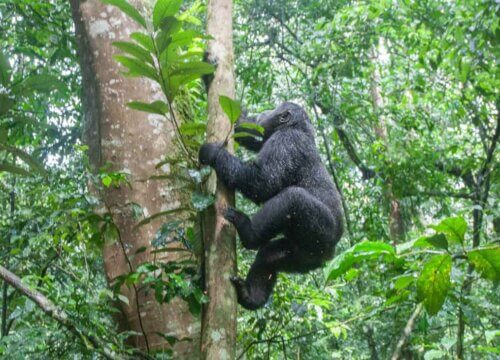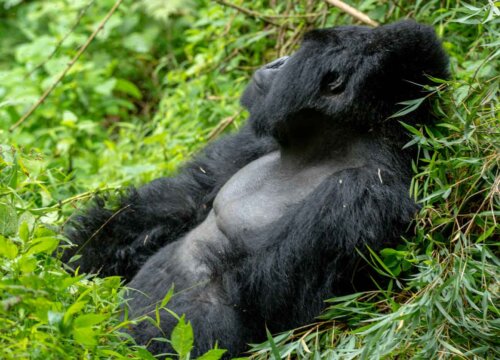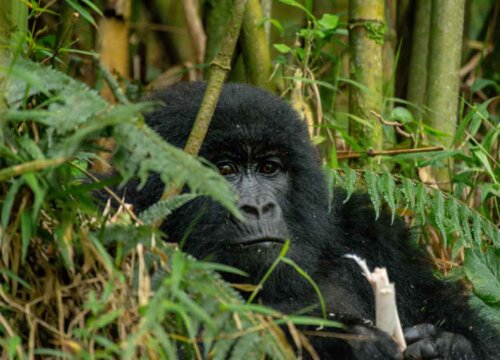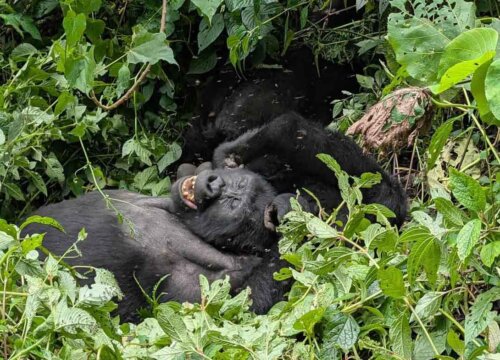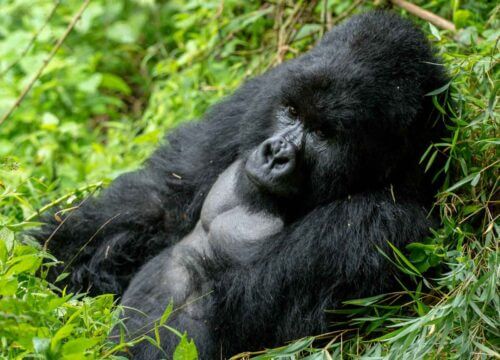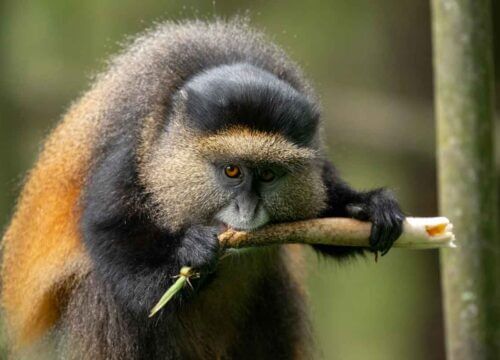Gorilla Habituation Experience in Bwindi Uganda
Gorilla Habituation Experience in Bwindi Uganda
Gorilla habituation experience is a carefully managed process where wild gorillas are gradually introduced to humans in a way that minimizes stress and fear. This process is usually conducted by trained researchers and conservationists over a period of years. Once gorillas are habituated, small groups of tourists can visit them under strict guidelines.
Why is gorilla habituation experience expensive?
Gorilla habituation in Bwindi Impenetrable National Park is a memorable activity that allows visitors to spend up to four hours with a semi habituated gorilla troop, observing their behavior and learning about their lives. However, this rare opportunity comes at a significant cost. Here are reasons why gorilla habituation in Bwindi Impenetrable National Park is considered expensive;
Conservation efforts
A large portion of the fees for gorilla habituation goes toward conservation. Mountain gorillas are critically endangered and protecting their habitat requires more resources. Funds are used for anti-poaching patrols, monitoring gorilla health and maintaining the integrity of Bwindi’s ecosystem. Without these efforts, the survival of these majestic creatures would be at great risk.
Limited availability
Gorilla habituation permits are highly limited to reduce human impact on the gorillas and their environment. Only a few visitors are allowed to participate each day ensuring the animals remain undisturbed. This exclusivity drives up the cost as demand usually outweighs supply.
Specialized training
The gorilla habituation process requires years of work by highly skilled trackers, researchers and conservationists. These experts spend countless hours in the forest, gradually getting the gorillas used to human presence while ensuring their safety. The cost of their training and expertise is reflected in the price of the experience.
Permit costs
The permit for gorilla habituation is more expensive than the standard gorilla trekking permit. This is because habituation involves a longer time with the gorillas up to four hours and a more immersive experience while gorilla trekking allows one hour of meeting gorillas. The higher price helps fund ongoing research and conservation projects in Bwindi Impenetrable National Park.
Remote location
Bwindi Impenetrable National Park is located in a remote area of Uganda, far from major cities and airports. Getting there requires significant logistical planning including transportation and accommodation in nearby lodges. The remote location adds to the overall cost of the experience.
Strict regulations
To protect the gorillas from human-borne diseases, strict regulations are enforced during gorilla habituation experiences. This includes maintaining a safe distance, wearing masks and limiting group sizes. Implementing and monitoring these regulations requires additional resources and staff which contributes to the higher expense.
Community involvement
Part of the revenue from gorilla habituation permits is shared with local communities around Bwindi Impenetrable National Park. This helps improve livelihoods through education, healthcare and infrastructure development. By involving local communities, conservation efforts gain more support but it also increases the overall cost of gorilla habituation experience.
High demand for unique experiences
Gorilla habituation is a rare and unique activity that is attractive to adventurous travelers and wildlife enthusiasts worldwide. The high demand for such an exclusive experience naturally drives up the price making it one of the most wanted wildlife encounters on the planet.
Long term commitment
Habituating a gorilla family to human presence takes years of consistent effort and funding. The process involves daily visits by researchers and trackers who must ensure that the gorillas remain comfortable and safe throughout the habituation period. This long-term commitment requires substantial financial investment.
Unmatched experience
Finally, the cost reflects the unequaled nature of the experience itself. Spending hours with mountain gorillas in their natural habitat is an extraordinary privilege that few people in the world will ever have. The memories created during this intimate encounter are priceless, making the high cost worth for many traveler. For more information about gorilla habituation permit booking, contact Giant Holiday Safaris.
Is gorilla habituation dangerous?
The short answer is that gorilla habituation is not dangerous but there are risks involved, both for humans and the gorillas themselves. Let us break it down in our article to understand why.
Risks to Humans
While gorillas are generally peaceful animals, they are still wild and strong. If they feel threatened, they may display aggression to protect themselves or their group. However, such incidents are rare during habituation experiences because trained guides and trackers accompany visitors at all times. These experts know how to read gorilla behavior and ensure safety by maintaining a respectful distance and following established protocols.
The more significant risk for humans is exposure to the dense forest environment, which can harbor insects, rough terrain or unpredictable weather. Visitors should come prepared with proper clothing, footwear and vaccinations to reduce these risks.
Risks to gorillas
Interestingly, the bigger concern lies with the gorillas themselves. Human presence can accidentally expose them to illnesses as their immune systems are not equipped to handle many human diseases. This is why strict health screenings and hygiene measures are enforced for anyone participating in gorilla habituation activities.
How to Stay Safe during gorilla habituation
If you are considering a gorilla habituation experience, the key is to follow all guidelines provided by your guides. Maintain a safe distance, avoid sudden movements and never attempt to touch or feed the gorillas. Respect their space, and remember that you are a guest in their home.
What is the best time to do gorilla habituation in Bwindi?
The best time for gorilla habituation in Bwindi is during the dry seasons which usually occur from June to August and December to February. During these months, the forest trails are less muddy and more manageable making your trek to the gorillas smoother and more enjoyable. Additionally, the weather is clearer offering better opportunities for photography and uninterrupted observation of the gorillas. Remember that Bwindi is a rainforest, so occasional showers can happen any time. On the other hand, If you visit during the wetter months of March to May or September to November, you will enjoy fewer crowds, a quiet and peaceful environment and vibrant scenery though the roads may be more slippery and challenging.
What is the age limit for gorilla habituation?
While this activity is open to many travelers, there is an age limit in place to ensure both the safety of participants and the wellbeing of the gorillas. The minimum age for gorilla habituation is usually 15 years. This restriction is designed by Uganda Wildlife Authority to prevent any potential risks as younger children may struggle with the physical demands of trekking through dense forests or could unintentionally disrupt the delicate gorilla habituation process. Additionally, this age requirement helps to minimize the possibility of transmitting illnesses to the gorillas because their immune systems are vulnerable to human diseases.
What to pack for a gorilla habituation trip
Comfortable hiking boots
Bwindi’s ground is rough, steep and often muddy. Look for boots with good ankle support and a strong grip to cross the dense forest paths. Breaking them in before your gorilla habituation trip is crucial to avoid blisters or discomfort during the trek.
Lightweight rain Jacket
Bwindi is a rainforest, so unexpected showers are part of the gorilla habituation trip. A lightweight, waterproof rain jacket will keep you dry without adding bulk to your pack. choose one that is breathable to avoid overheating during the hike.
Long sleeved shirts and trousers
Protect yourself from insect bites, thorny plants and sun exposure by wearing long-sleeved shirts and trousers. Lightweight fabrics are best for staying comfortable in the humid environment. Neutral colors like green or khaki are recommended to blend in with the surroundings during gorilla habituation trek.
Gardening gloves
Gardening gloves are very useful for protecting your hands as you grab onto branches or vines for support during the trek. They also protect your skin from stinging nettles and other irritants commonly found in the forest during gorilla habituation.
Gaiters or waterproof socks
To keep your feet dry and protect them from mud or small insects, consider packing gaiters or waterproof socks. They act as an additional barrier against the damp forest floor, ensuring your comfort throughout the day.
Daypack with hydration system
A comfortable daypack is essential for carrying your essentials like water, snacks and extra layers. A hydration system or water bottle is important for staying hydrated during the physically demanding trek.
Energy snacks
The trek can be long and tiring, so packing high energy snacks like dried fruits is a good idea. These will provide a quick energy boost when you need it most.
Camera with extra batteries
Capturing moments with the gorillas during gorilla habituation is something you will treasure forever. Bring a good quality camera or smartphone with extra batteries and memory cards to ensure you do not miss any shots. Remember to turn off the flash to avoid disturbing the gorillas.
Insect repellent and sunscreen
Mosquitoes and other insects are common in Bwindi, so a strong insect repellent is a must. Additionally, sunscreen will protect your skin from sun rays even under the forest canopy.
Travel documents and permits
Do not forget your travel documents including your passport, gorilla habituation permit and any necessary medical certificates such as proof of yellow fever vaccination. Keep them in a waterproof bag for safekeeping in case of unexpected rain. For more information about gorilla habituation in Bwindi Impenetrable Forest National Park, contact Giant Holiday Safaris.
Explorer More Safaris
- 14-Days Uganda Safari Gorilla Chimpanzees and Wildlife
- 12 Days Gorillas and Chimpanzees Wildlife Safari
- 10 days best of uganda primates & wildlife safari
- 6 Days Gorillas and Chimpanzee Trekking Safari
- 3 Day Bwindi Gorilla Trekking Safari
- 4 Day Uganda Gorilla Trekking and Wildlife Safari
- 4 Days Gorilla Trekking and Adventure Safari
- 5 Days Uganda Gorillas and Chimpanzee Tracking Safari
- 4-Day Rwanda Gorilla Trekking and Golden Monkey Tracking Safari
- 5 Day Gorilla Habituation and Chimp Trekking
- 4-Day Uganda & Rwanda Gorilla Trekking Tour
- 3 Days Bwindi Gorilla Trekking Ugnada from Rwanda
- 10 Days Uganda Primates and Game Safari

